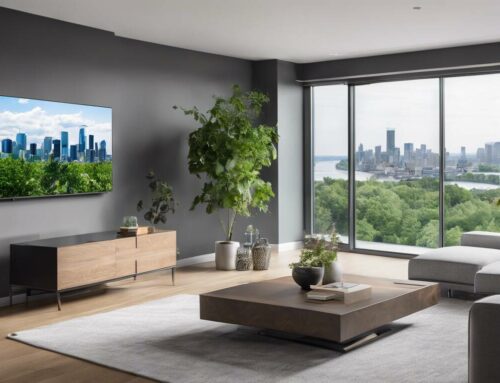January 26, 2024
Dangers of Indoor Air Pollution in Montreal: Health Risks and Prevention

Indoor air pollution in Montreal is a cause for concern due to pollutants like volatile organic compounds, tobacco smoke, among others. These common pollutants, often overlooked, pose a significant risk to your well-being when present in your home or office. However, something that may come as a surprise is that outdoor pollution particles can slip into your indoor spaces too, further intensifying the problem. Local testing services bring hope by not just identifying these hidden threats but also suggesting useful actions to improve your air quality.
The primary dangers of indoor air pollution in Montreal include respiratory issues, exacerbation of existing health conditions, and potential long-term effects on overall health. Common pollutants such as mold, volatile organic compounds (VOCs), and allergens can contribute to these risks. It’s crucial to schedule air quality testing to identify and address any indoor air quality concerns promptly.
Overview of Indoor Air Pollution in Montreal
Montreal, with its bustling urban landscape, grapples with its fair share of indoor air pollution challenges. The city experiences a combination of volatile organic compounds (VOCs) emitted from household products, tobacco smoke, cooking emissions, and off-gassing from building materials that contribute to a mélange of pollutants impacting indoor air quality. Additionally, outdoor pollution in the form of particulate matter can infiltrate indoor spaces, further exacerbating air quality concerns.
Volatile organic compounds, or VOCs, significantly contribute to indoor air pollution in Montreal. They emanate from a variety of sources such as paint, cleaning supplies, adhesives, and furniture. While many household products release VOCs, long-term exposure to these compounds can lead to respiratory problems and eye irritation. The accumulation of these hazardous substances underscores the criticality of regular air quality testing in homes and commercial spaces across the Montreal area.
Montreal’s geographical location plays a significant role in the infiltration of outdoor pollution into indoor environments. The city’s proximity to major roadways and industrial zones means that air pollution from these external sources can easily seep indoors, adding another layer of complexity to maintaining clean indoor air.
For instance, harmful fine particulate matter from vehicle exhaust and industrial emissions finds its way inside homes and offices, affecting the overall health and well-being of individuals. This mixture of outdoor pollutants intermingling with already present indoor pollutants creates a cumulative effect on indoor air quality—highlighting the pressing need for comprehensive air quality testing services such as those offered by our business at Air Quality Testing.
Understanding the unique combination of pollutants that affect Montreal’s indoor air quality is essential in taking proactive steps towards addressing these issues. In light of these significant challenges posed by pollutants both within and outside living and working spaces, reliable methods for testing and improving indoor air quality are paramount.
Shedding light on the complex dynamics of indoor air pollution prepares us to explore the various sources contributing to this critical issue. As we unravel these components together, a clearer understanding emerges of how pervasive these pollutants are in our daily lives.
Common Sources of Indoor Air Pollution
When we think about air pollution, images of smoggy skies and industrial emissions often come to mind. However, it’s important to recognize that indoor air pollution can be a significant issue as well. Many common household items contribute to this problem in ways that may not be immediately apparent.
Household Products
Household products play a significant role in indoor air pollution. Cleaning agents, air fresheners, and personal care items often contain volatile organic compounds (VOCs), which are chemicals that can vaporize at room temperature. These chemicals are released into the air during use, significantly impacting indoor air quality. It’s important to use these products in well-ventilated areas or consider using natural alternatives to reduce VOC exposure.
For instance, when you clean your home or do laundry using conventional cleaning products, you might unknowingly release harmful substances into the air. Think of it like adding invisible pollutants to the environment inside your own home! These VOCs can contribute to respiratory problems, allergic reactions, and other health issues over time.
Mold and Mildew
Mold and mildew are common culprits of poor indoor air quality. Moisture-related issues in bathrooms, kitchens, or poorly ventilated areas provide ideal conditions for mold growth. As mold thrives, it releases spores and mycotoxins into the air, degrading the indoor air quality. This can lead to a range of health issues, particularly for those with respiratory conditions or allergies.
Dealing with mold may involve addressing underlying moisture issues and ensuring adequate ventilation in areas prone to dampness. It’s crucial to tackle these problems promptly to prevent further mold growth and safeguard indoor air quality.
Tobacco Smoke
Tobacco smoke is another significant contributor to indoor air pollution. Secondhand smoke and lingering odors from tobacco products can present substantial challenges for maintaining clean indoor air. People who are exposed to secondhand smoke may experience health issues like asthma attacks, respiratory infections, and reduced lung function.
Imagine a situation where someone smokes indoors regularly. Even if they smoke in one room with the door closed, the lingering smell and harmful particles from the tobacco smoke spread around the house. This constant exposure can have detrimental effects on everyone living in that environment.
Building Materials
Building materials and furnishings used indoors also impact indoor air quality. Off-gassing from paints, carpets, adhesives, and furniture can release harmful chemicals into the air. This off-gassing process can continue for an extended period after installation or application of these materials.
For example, when new carpeting is installed or painting is done within a space, it’s not just the initial fumes that pose a risk – those fumes can linger for quite some time and contribute to ongoing indoor air pollution.
The impact of these sources on our daily lives is often underestimated. It’s crucial to recognize them so that we can take steps to mitigate their effects on our indoor environments.
Understanding and acknowledging these common sources of indoor air pollution sets the stage for implementing effective prevention strategies – something we’ll explore next.
Health Impact of Indoor Air Pollution and Affected Demographics

When it comes to detrimental effects on our health, indoor air pollution isn’t a minor issue. Breathing in dirty air can lead to serious health problems, especially if the pollutants are present over a long period. Poor indoor air quality has been linked to respiratory problems, aggravated allergies, skin irritations, and even more severe issues like cardiovascular problems and lung cancer. According to the World Health Organization (WHO), exposure to indoor air pollution is a major contributor to the global burden of disease, causing an estimated 3.8 million premature deaths each year.
Who’s at the greatest risk? Well, vulnerable populations are at the top of that list—this includes young children who are still developing, the elderly whose immune systems may not be as strong, and people with pre-existing respiratory conditions such as asthma or chronic obstructive pulmonary disease (COPD). For these groups, exposure to poor indoor air quality can exacerbate existing health issues and lead to frequent hospital visits.
Imagine being a child with asthma who lives in an environment with poor air quality—it’s like trying to run a race but being tied to a weight. The pollution makes it harder for you to breathe and can trigger asthma attacks, making it tough for you to simply play or enjoy your childhood.
Now that we understand the significant health impacts caused by indoor air pollution and its disproportionate effect on vulnerable populations, let’s discuss how we can take steps to mitigate these risks.
The focus now shifts from acknowledging the health risks associated with indoor air pollution to learning about the measures we can employ to minimize these dangers effectively.
Reduction and Elimination of Indoor Air Pollution Sources
When it comes to reducing indoor air pollution, several effective strategies can be implemented in homes and buildings. Let’s explore these key methods and see how they can effectively mitigate and prevent the buildup of harmful pollutants.
Proper Ventilation
One of the most crucial tools for combating indoor air pollution is proper ventilation. This involves implementing adequate ventilation systems in homes and buildings to introduce fresh outdoor air and exhaust stale indoor air. Adequate ventilation helps dilute and remove pollutants such as volatile organic compounds (VOCs) and airborne particles. An efficient ventilation system can significantly improve indoor air quality by reducing the concentration of pollutants, preventing them from accumulating to harmful levels. By allowing fresh air to circulate and replacing stagnant indoor air, proper ventilation also helps maintain a healthy and comfortable indoor environment.
Source Control
Another effective approach to reducing indoor air pollution involves addressing specific sources of contaminants. For instance, mold remediation is essential for preventing mold growth and addressing existing mold issues, which can release spores and mycotoxins into the air, contributing to respiratory problems and other health issues. Additionally, reducing the use of VOC-emitting products such as paints, cleaning agents, and aerosol sprays can help minimize the release of harmful chemicals into the indoor environment. Implementing smoking bans indoors is another crucial step in source control, as tobacco smoke is a significant source of indoor air pollutants that pose serious health risks. By taking proactive measures to control and minimize specific pollution sources, individuals can effectively reduce the overall burden of indoor air pollutants.
Air Quality Testing
Seeking professional air quality testing services from certified experts can provide valuable insight into the specific pollutants present in indoor environments and their sources. Professional testing can identify a wide range of contaminants including mold spores, asbestos fibers, VOCs, radon gas, and other hazardous substances that may impact indoor air quality. By partnering with reputable environmental testing professionals such as those at AirQualityTesting.ca, individuals can gain access to comprehensive assessments that pinpoint specific pollutants and their origins within their homes or buildings. These insights enable targeted actions for improvement, empowering individuals to implement tailored solutions for mitigating indoor air pollution and creating healthier indoor environments for themselves and their families.
By prioritizing proper ventilation, addressing specific sources of contamination, and seeking professional air quality testing services, individuals can proactively reduce and eliminate indoor air pollution sources, contributing to improved overall indoor air quality and promoting better health outcomes.
Now equipped with an understanding of how to effectively reduce indoor air pollution sources, let’s move our focus towards deliberate measures aimed at improving overall indoor air quality.
Effective Measures to Improve Indoor Air Quality
Improving indoor air quality is essential, particularly in densely populated urban environments like Montreal. Let’s explore some effective methods to enhance the air we breathe indoors.
Air Purification
One of the key strategies for improving indoor air quality entails utilizing high-efficiency particulate air (HEPA) filters and air purifiers. HEPA filters are meticulously designed to capture small particles and allergens, efficiently removing them from the air. Air purifiers, equipped with HEPA filters, can be notably beneficial for individuals sensitive to airborne particulates or suffering from allergies. By effectively capturing and eliminating contaminants, these devices greatly contribute to better indoor air quality, making it clearer and safer to breathe.
Humidity Control
Another pivotal factor in maintaining good indoor air quality is humidity control. Maintaining indoor humidity levels between 30-50% is crucial in inhibiting mold growth and preventing the exacerbation of indoor air quality issues. The use of dehumidifiers or ensuring proper ventilation within a living space can play a key role in achieving optimal humidity levels. Mold spores thrive in damp environments, and controlling humidity levels inhibits their growth, significantly enhancing indoor air quality.
Regular Maintenance
Frequent cleaning and vacuuming are key aspects of regular maintenance that contribute to cleaner indoor air. Utilizing vacuum cleaners with HEPA filters ensures that dust, dander, and other allergens are efficiently captured rather than being circulated back into the air. Additionally, changing HVAC system filters on a regular basis is crucial for preventing the accumulation of contaminants within the ductwork, thus promoting cleaner and healthier indoor air.
Consider this: Imagine your HVAC system filter as a net capturing debris from the air in your home. Just as you wouldn’t want a torn net for catching fish, a clogged or dirty HVAC filter impedes its ability to catch dust and allergens efficiently.
By focusing on these effective measures—utilizing air purifiers with HEPA filters, controlling humidity levels, and diligently maintaining cleanliness through frequent cleaning and filter changes—we can significantly improve the indoor air we breathe in Montreal. These simple steps pave the way for a healthier living environment while reducing potential health risks associated with poor indoor air quality.
Heading into the next section uncovers actionable steps that bridge theory with practice—practical tips that offer a roadmap toward healthier breathing spaces in Montreal’s homes and buildings.
Practical Tips for Indoor Air Pollution Prevention in Montreal
Living in a beautiful city like Montreal comes with its own challenges, and one of them is dealing with indoor air pollution. Ensuring clean, healthy air within our homes is essential for our well-being. Let’s discuss practical tips on how to prevent indoor air pollution and promote a healthier environment for ourselves and our families.
No Smoking Policy
Implementing a strict no-smoking policy in indoor spaces can significantly reduce the influx of tobacco smoke and its associated pollutants. Not only does secondhand smoke contain harmful chemicals that can linger in the air and on surfaces, but it also poses serious health risks, especially for children and those with respiratory conditions. Establishing designated outdoor smoking areas can help minimize the impact of cigarette smoke on indoor air quality within residential buildings and shared spaces.
Green Cleaning Products
Encouraging the use of eco-friendly and low-VOC (volatile organic compound) cleaning products is another important step in reducing indoor air pollution. Many conventional cleaning agents contain high levels of VOCs, which contribute to poor indoor air quality. By promoting the use of environmentally friendly cleaning products, we can minimize the release of harmful chemicals into the air, creating a safer and healthier environment for everyone indoors.
It’s important to educate individuals on the benefits of green cleaning products and how they contribute to improved indoor air quality.
Indoor Plants
Incorporating air-purifying plants into our homes and workspaces is a natural and aesthetically pleasing way to reduce certain airborne pollutants and enhance indoor air quality. Plants such as peace lilies, spider plants, and pothos not only add a touch of greenery to our surroundings but also act as natural filters, removing toxins from the air through the process of photosynthesis.
Studies have shown that certain houseplants can effectively remove common indoor pollutants such as formaldehyde, benzene, and trichloroethylene. By strategically placing these air-purifying plants throughout indoor spaces, we can create cleaner, fresher air for ourselves and our families.
Implementing these practical measures not only helps us combat indoor air pollution but also fosters a healthier living environment for everyone in Montreal.
In this high-stakes game of preserving our health by keeping our indoor environments safe from pollutants, informed action may very well be key to success. Call us at 450-390-6413 or visit Air Quality Testing Montreal to schedule professional air quality testing services and safeguard your home.



